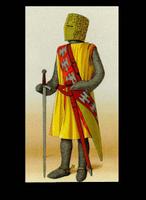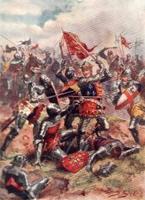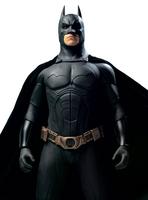 By 1066, Roman segmented armor had disappeared. What survived was the chain mail that the Romans had adopted from the Celts over a thousand years earlier. A chain mail hauberk, as seen on the left, could weigh between 40 and 80 pounds depending on the length and whether the chain was single or double. Chain mail gave good coverage against slashes and thrusts. It stayed close to the body so it allowed the widest range of motion for arms and legs.
By 1066, Roman segmented armor had disappeared. What survived was the chain mail that the Romans had adopted from the Celts over a thousand years earlier. A chain mail hauberk, as seen on the left, could weigh between 40 and 80 pounds depending on the length and whether the chain was single or double. Chain mail gave good coverage against slashes and thrusts. It stayed close to the body so it allowed the widest range of motion for arms and legs.  Swords of the time were modeled after the viking sword. Knights had learned not to sharpen their swords into fine edges because the iron would not hold the edge and it routinely broke against shields and chain mail. Instead, the sword acted largely as a blunt object that could bludgeon a warrior to death or knock him down in order for his opponent to deliver the coup de gra' thrusting the pointed end of the sword in the face opening, into the groin area or simply bludgeoning his head in. Any amputation or deep penetrating wounds could be more contributed to by the heft of the sword and the power of the warrior swinging it.
Swords of the time were modeled after the viking sword. Knights had learned not to sharpen their swords into fine edges because the iron would not hold the edge and it routinely broke against shields and chain mail. Instead, the sword acted largely as a blunt object that could bludgeon a warrior to death or knock him down in order for his opponent to deliver the coup de gra' thrusting the pointed end of the sword in the face opening, into the groin area or simply bludgeoning his head in. Any amputation or deep penetrating wounds could be more contributed to by the heft of the sword and the power of the warrior swinging it.
The two main types of wounds that warriors suffered with this armor were blunt force trauma and penetrating wounds from arrows. Even with double chain an arrow could penetrate the coat of mail taking pieces of the armor with it. If the warrior didn't die of a direct wound to an organ, he would most likely die from infection caused by the material of his tunic, chain mail and any dirt that followed the arrow in. Then there was the open face of the armor itself. In 1066, King Harold was killed by a Norman arrow that struck him in the eye.
To combat the effects of blunt force trauma and penetration by arrows, armorers began to experiment with different armor techniques. First they added padding behind the chain mail hauberk. The padded, quilted long shirt was called a gambeson. This helped disipate the force of a blow by first pushing the chain mail out so that it was "stiffer" and the rings locked to add resistance. Then, the padding itself absorbed the energy of the blow. Of course, this added weight and had some issues with mobility. It also did not protect well against penetration by arrows.
Next armorers developed bar armor that was usually sown to a leather backing and covered with the cloth of a surcoat or leather. This was often worn over the top of the chain mail to provide protection against penetrating wounds from arrows, thrusts from swords and, along with the padded gambeson, eliminated some blunt force trauma injuries from swords. Appendages were still vulnerable though chain hauberks had been extended to cover the arms and legs.
The bucket helmet no longer deflected blows, but the shape allowed the head to be hit without significant penetration, however, a knight could still be knocked silly. The "folds" in this knights surcoat aren't folds at all but bars of iron sewn vertically into the front of the surcoat to provide extra protection. Sadly, this knight saw new weapons enter the battle field.


 The bodkin arrow head was stronger and could penetrate armor. The mace and the flail could both cause extreme blunt force trauma even to the head covered by the new improved bucket helmet and the two handed great sword had new improved tempering and hardening methods creating a stronger sword. The "blood groove" allowed some weight to be removed from the sword while maintaining it's strength and balance. The sword could be between 4 and 6 feet. This sword could actually hack off limbs and heads. These new weapons meant that chain mail and bar armor had been out stripped by the weapons manufacturers once again.
The bodkin arrow head was stronger and could penetrate armor. The mace and the flail could both cause extreme blunt force trauma even to the head covered by the new improved bucket helmet and the two handed great sword had new improved tempering and hardening methods creating a stronger sword. The "blood groove" allowed some weight to be removed from the sword while maintaining it's strength and balance. The sword could be between 4 and 6 feet. This sword could actually hack off limbs and heads. These new weapons meant that chain mail and bar armor had been out stripped by the weapons manufacturers once again.
What were the armorers to do? They needed better coverage without sacrificing mobility and strength. On the other hand, the weapons were now so dangerous that a small amount of speed could be sacrificed to gain survivability. By the time of the Black Prince, plate armor had become a common site on the field of battle. Armorers began to use the hardening and tempering methods first used for swords, transfering the technique to plate armor. The armor was still quite heavy, but provided the most protection yet from arrows and blunt force trauma to the torso. To lighten the weight of the plate armor and add strength, armorers began to bend the armor. As can be seen by the armor in the prince's effigy, the breast plate created a shell that tapered in towards the waist. The curve of the shell helped deflect blows, disipated the impact (and energy) of a blow over a wider area and kept the impact at least two inches away from the knight's body. The tapering at the waist allowed some of the weight of the armor to be distributed from the shoulders to the hips. Beneath this tapered waist, unseen due to the surcoat worn over the armor, was an articulated bell "skirt" that protected the groin, hips and thighs. Plate armor was also used to develop vambraces for the forearm, gauntlets for the hand and articulated shoulder, leg and knee protection.
By the time of the Black Prince, plate armor had become a common site on the field of battle. Armorers began to use the hardening and tempering methods first used for swords, transfering the technique to plate armor. The armor was still quite heavy, but provided the most protection yet from arrows and blunt force trauma to the torso. To lighten the weight of the plate armor and add strength, armorers began to bend the armor. As can be seen by the armor in the prince's effigy, the breast plate created a shell that tapered in towards the waist. The curve of the shell helped deflect blows, disipated the impact (and energy) of a blow over a wider area and kept the impact at least two inches away from the knight's body. The tapering at the waist allowed some of the weight of the armor to be distributed from the shoulders to the hips. Beneath this tapered waist, unseen due to the surcoat worn over the armor, was an articulated bell "skirt" that protected the groin, hips and thighs. Plate armor was also used to develop vambraces for the forearm, gauntlets for the hand and articulated shoulder, leg and knee protection.
Certain areas still remained vulnerable to piercing: the under arm, the neck and the back of the leg. The helmet and coif did little to protect against blunt weapons like a mace or war hammer. The new improved great sword could still cut an arm or a leg off when wielded properaly and a short sword or dagger would be thrust into the other vulnerable areas.  The English archers at Agincourt used this vulnerability to their advantage, unhorsing the knights by killing or wounding their horses and then knocking the knight to the ground if they weren't outright killed by an arrow. Once they were on the ground, the archers beat them upon the head or slashed the backs of their legs to immobilize them. Then, holding the knight's arm out and thrusting into the arm hole on the armor to puncture lungs, heart and cut arteries or pushing a dagger into the face opening of the coif, thrusting down until they had cut the carotid artery. Sometimes a dagger or sword would be thrust under the coif from the bottom or even under the bell hoop of the armor into the groin. In most cases, if the knight was not lucky enough to have his brains beat out with a mace or club, he bled to death in minutes, and occasionally hours, lying on a muddy, bloody field.
The English archers at Agincourt used this vulnerability to their advantage, unhorsing the knights by killing or wounding their horses and then knocking the knight to the ground if they weren't outright killed by an arrow. Once they were on the ground, the archers beat them upon the head or slashed the backs of their legs to immobilize them. Then, holding the knight's arm out and thrusting into the arm hole on the armor to puncture lungs, heart and cut arteries or pushing a dagger into the face opening of the coif, thrusting down until they had cut the carotid artery. Sometimes a dagger or sword would be thrust under the coif from the bottom or even under the bell hoop of the armor into the groin. In most cases, if the knight was not lucky enough to have his brains beat out with a mace or club, he bled to death in minutes, and occasionally hours, lying on a muddy, bloody field.
Two weapons on this field would turn the history of armor once again.  The French used crossbows on the field of Agincourt. The problem here was that the crossbow as not much for distance. At a hundred yards or less it could send a bolt through plate armor. At greater distances accuracy would fail but a bolt could still be lodged in the vulnerable neck, armpit and back's of legs not covered by plate armor. As an anti-siege weapon, it was very effective.
The French used crossbows on the field of Agincourt. The problem here was that the crossbow as not much for distance. At a hundred yards or less it could send a bolt through plate armor. At greater distances accuracy would fail but a bolt could still be lodged in the vulnerable neck, armpit and back's of legs not covered by plate armor. As an anti-siege weapon, it was very effective. 
The English, on the other hand, made great use of the longbow. It had the advantage of distance and, fired en masse, 1500 archers could deliver an estimated 9000 arrows on target within a minute (6/min) at distances of 300 yards. At 100 yards or less, the longbow was as deadly as it's step child the crossbow. The only difference was that crossbowmen needed little training to operate their weapon and longbow archers perfected theirs over years. Crossbows also took longer to "re-load". The hoop like structure on the crossbow above was for the archer's foot. Holding the crossbow in place, he would pull the string back to lock, bring it up, place a bolt, bring it to his shoulder, aim and fire. A good crossbowman might get off 3 to 4 shots in a minute.
The danger lay in the penetrating power of these weapons. With new and improved arrow heads, they were absolutely deadly. For the armorers it was back to the drawing table. Enter the fully armored knight. Armorers were once again tasked with creating a stronger, lighter and more fully protective suit of armor. By the time of this late 15th century armor, the techniques of hardening and tempering iron into steel were fully developed. The new armor plates were extremely strong. This meant the armor could be thinner and lighter. the armor plate on this suit of armor could be beaten into a 1/4" or less. To stengthen and lighten the armor even more, the armor was contoured and fluted. The convex shape of the breast plate distributed energy and force of the blow as well as kept the blow far away from the knights torso. The fluting provided additional strength while removing some of the metal from the plate, lightening the weight considerably while still maintaing good coverage from penetration.
Enter the fully armored knight. Armorers were once again tasked with creating a stronger, lighter and more fully protective suit of armor. By the time of this late 15th century armor, the techniques of hardening and tempering iron into steel were fully developed. The new armor plates were extremely strong. This meant the armor could be thinner and lighter. the armor plate on this suit of armor could be beaten into a 1/4" or less. To stengthen and lighten the armor even more, the armor was contoured and fluted. The convex shape of the breast plate distributed energy and force of the blow as well as kept the blow far away from the knights torso. The fluting provided additional strength while removing some of the metal from the plate, lightening the weight considerably while still maintaing good coverage from penetration.  It's at this point that the arms race speeds up considerably. This crossbow shows a winding handle used to pull the bow string back. That's because the cross section is now made of a thin, highly flexible steel that allows a bolt to be fired that can still penetrate the new plate armor at 100 yards or less. Unfortunately for the archer, he is lucky if he gets off two arrows in a minute or before the well armed knight cuts him down.
It's at this point that the arms race speeds up considerably. This crossbow shows a winding handle used to pull the bow string back. That's because the cross section is now made of a thin, highly flexible steel that allows a bolt to be fired that can still penetrate the new plate armor at 100 yards or less. Unfortunately for the archer, he is lucky if he gets off two arrows in a minute or before the well armed knight cuts him down.  Theopen field now belongs to the medieval tank. In response, the infantry develops long spears to use in a phalanx to break up charges.
Theopen field now belongs to the medieval tank. In response, the infantry develops long spears to use in a phalanx to break up charges.  The halberd is equally dangerous. The hook on the back is used to grab an armored knight and pull him to the ground. The steel spear can thrust through the plate armor or into vulnerable areas (still around the groin and arm pit). Other hooked weapons of the period resemble a can opener for good reason. The only way the infantry is going to kill this knight is up close and personal.
The halberd is equally dangerous. The hook on the back is used to grab an armored knight and pull him to the ground. The steel spear can thrust through the plate armor or into vulnerable areas (still around the groin and arm pit). Other hooked weapons of the period resemble a can opener for good reason. The only way the infantry is going to kill this knight is up close and personal.  Even a knight on the ground is well enough covered that a foot soldier will have to fight him to exhaustian or find a way to put him and keep him on the ground so the foot soldier or a compatriot can open up the armor or expose the two remaining vulnerable areas (armpit and groin). An ingenious tool for this chore is the attrape coquin, aptly translated as the "rascal catcher". This device will grab an armored man around the neck and then the foot soldier uses the length of the staff as a lever to pull the man down. The footsoldier is still at a distinct disadvantage until he gets two new weapons:
Even a knight on the ground is well enough covered that a foot soldier will have to fight him to exhaustian or find a way to put him and keep him on the ground so the foot soldier or a compatriot can open up the armor or expose the two remaining vulnerable areas (armpit and groin). An ingenious tool for this chore is the attrape coquin, aptly translated as the "rascal catcher". This device will grab an armored man around the neck and then the foot soldier uses the length of the staff as a lever to pull the man down. The footsoldier is still at a distinct disadvantage until he gets two new weapons: The arquebus...
The arquebus... ...And the cannon.
...And the cannon.
In the beginning, cannon are largely used as siege machines to break down walls of cities or fortresses. They aren't particularly accurate and the exploding round has not been developed. Use against infantry or knights is relatively useless until the mid to late 17th century. The arquebus has a similar problem. It's accuracy leaves much to be desired, but it's impact will change the face of warfare forever.
Within 100 years of the siege of Boulogne (pictured on the right), the fully armored warrior disappears forever.
Or, does he? In 1942, an English Major proposes providing bomber crews with chain mail armor covered by cloth to protect them against AAA flak. In 1943, a flight surgeon, Col. Malcom G. Grow is awarded the Lefion of Merit for his role in developing the flak jacket that will protect American bomber crews. This flak jacket is comprised of steel plates covered by canvas. Bomber crews wear modified steel helmets and heavily padded jackets, pants, gloves and boots to protect them against the cold.
In 1942, an English Major proposes providing bomber crews with chain mail armor covered by cloth to protect them against AAA flak. In 1943, a flight surgeon, Col. Malcom G. Grow is awarded the Lefion of Merit for his role in developing the flak jacket that will protect American bomber crews. This flak jacket is comprised of steel plates covered by canvas. Bomber crews wear modified steel helmets and heavily padded jackets, pants, gloves and boots to protect them against the cold.
The military "discovers" fiberglass and the new armored vests are sent to Korea. The quarter master reminds everyone that the vests are for stopping fragments and shrapnel, not bullets. There are no "bullet proof vests" because they would be too large and bulky. In 1965, Dupont creates Kevlar16. A new vest is created using 24 layers of kevlar and is reported to stop magnum size loads. Unfortunately, it still cannot stop a high powered rifle bullet. In 1982, a ceramic aluminum oxide plate is added to the vest and the layers of kevlar are reduced, reducing the over all weight to approximately 25lbs.
In 1965, Dupont creates Kevlar16. A new vest is created using 24 layers of kevlar and is reported to stop magnum size loads. Unfortunately, it still cannot stop a high powered rifle bullet. In 1982, a ceramic aluminum oxide plate is added to the vest and the layers of kevlar are reduced, reducing the over all weight to approximately 25lbs.  enter the interceptor. It weighs 16.5lbs including 8.5lbs of kevlar vest and 4lbs each (2) of Spectra re-enforced boron carbide ceramic plates (not including groin and arm protection). It can take between 5 and 7 AK 47 7.62mm rounds before shattering the plate.
enter the interceptor. It weighs 16.5lbs including 8.5lbs of kevlar vest and 4lbs each (2) of Spectra re-enforced boron carbide ceramic plates (not including groin and arm protection). It can take between 5 and 7 AK 47 7.62mm rounds before shattering the plate.
What can modern armor manufacturers and the Natick Soldier Systems Center learn from this history?
It's not necessary to re-invent the wheel to provide good protection for a warrior. In reality, only the materials change. The practical shapes and engineering remain the same.
New materials can often allow new designs in creating armor, but old engineering of past armor can play a significant role in speeding up the process of creating new armor. In this case, convex shapes, contours and fluting can improve the strength of hardened materials while simultaneously decreasing the weight through reduction of materials. It may be possible to decrease blunt force trauma and increase the durability of modern ceramic plates by exploring new shapes. These new shapes, contouring and fluting, could be transferred to leg and arm protection. It may even allow the helmet to change and allow additional armor to be carried by the soldier.
Considering some of the issues confronting the ceramic plates, it might be an opportune time to investigate these techniques.
Or, they can ask... The Greeks
The Greeks The Romans
The Romans And the knight.
And the knight.
Or maybe they should ask... ...Batman. His armorer seems to know what he's doing.
...Batman. His armorer seems to know what he's doing.
Stay tuned for part four: What the Greeks, the Romans and the Medieval knight knew about saving Ryan's privates.
Russia Is the World’s Worst Patron
1 day ago




















2 comments:
Excellent series of posts!
/TJ
... NIF
nice post love reading it
Post a Comment